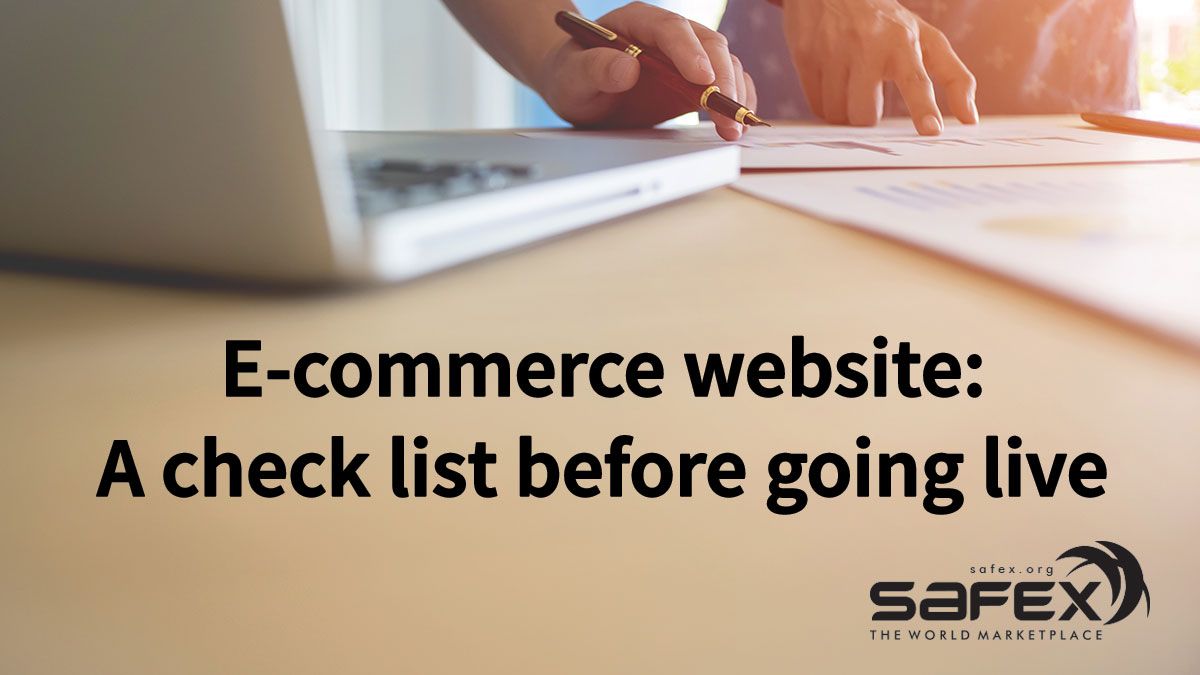Test plan for your E-commerce website: A check list before going live
Before launching an eCommerce website, it is important to process a test plan in order to ensure that the user experience meets the customers' expectations. It is critical for the building of trust that users can navigate your website effortless and feel secure during their shopping experience.

Launching an eCommerce website is a complex process that requires a lot of prior checks, modifications and an eye for detail. Whether you start your first eCommerce website or just want to do a redesign, multiple changes and checks if everything functions well are inevitable. The whole process will be likely much easier if your approach to launching an eCommerce website is well structured and planned.
The types of testing you should run on your eCommerce store before a launch should include the following ones:
- Functional testing
- Usability testing
- Performance testing
- Mobile application testing
- Database testing
- Security testing
- A/B testing
The following information should serve as a check list of a test plan for an eCommerce website that will facilitate the whole process of testing and ensure that your online store meets all of your customers' expectations.
Homepage
The homepage will be the first page your customers will land on. This page has got huge potential of directing them to the most important other pages and displayed products on your website. Newsletter subscriptions, discount pop-ups, search boxes, featured products, special offers, contact information and an easy navigation menu are essential elements of every homepage and can help you to increase your sales volume. Before launching your eCommerce store, make sure to test if each of those elements is set up properly and does function well so that your customers can easily navigate on it.
Contact page
Another very important page of your eCommerce website for building trust is a contact page. This page should contain all your contact information such as call-center numbers, address, map and email address. You should always have in mind that online shopping means a lack of contact with the products themselves and the possibility of raising questions about them. For that reason, the ability of easily contacting your support is of essential importance for your customers.
Frequently Asked Questions page
A Frequently Asked Questions page may significantly shorten the customers' final purchase decision by answering all of the most asked questions about the product, service, shipping process, etc. The most frequently asked questions usually include topics such as shipping information and conditions, return policy and terms.
Product pages
When processing a test plan for an eCommerce website, the most difficult task is usually related to the product pages since there might be thousands of different products listed on such a store. Not only that the description and presentation of your products must be flawless but the product category pages must be set up well, too. If you want to provide a smooth online shopping experience for your customers, then make sure your product category pages contain the following:
- Product display filters for the colors, sizes, types of products, etc.
- Filters that will sort products by price, name, etc.
- Buttons enabling to add the product to the cart or a wishlist
- Delivery options
- Shipping details
- In-stock/Out-of-stock information
Although this might seem like an endless testing process, it is indispensable since it will direct your customers' buying journey in many ways.
Shopping cart
Whenever a customer fails to add a product to the shopping cart, this ultimately leads to cart abandonment. Since it defines the final product's price depending on shipping type or other services, a smooth shopping cart process is crucial.
- Shopping cart features should contain a possibility to calculate all the additional costs such as shipping costs or taxes.
- All items and their total prices should be displayed clearly.
- The shopping cart must allow the possibility to remove items from it again.
- Continuing shopping after adding the items to the cart has to be enabled.
- Proceeding to checkout must not be interrupted in any way.
Checkout experience
Enabling your customers to finish the purchasing process is of tremendous importance for your business if we take into account that the average cart abandonment rate, according to the Baymard Institute, amounts to 75.6%. There are various reasons why people may leave the cart before finishing the purchase. However, the checkout experience is one of the most important parameters that influences the users' final purchase decisions. For that reason, you have to do your best to make this process perfect.
Before you drive any traffic to your eCommerce store, it would be the best to check if the following features are implemented:
- Customers can edit their cart's content.
- Shipping rates are clearly presented during the checkout process.
- Discount codes can be applied to the cart.
- Multiple payment methods are available and functional.
- Order status tracking is available.
- The contact page is visible and easily accessible.
- The delivery of purchasing confirmation via email is enabled.
- A shipping policy is presented clearly in various languages, setting who pays duties and taxes.
- A currency switcher would be a very helpful tool on your checkout page.
Payment systems
The payment system is another necessary test plan for an eCommerce website because it will majorly determine your future revenue. This is why you should enable multiple payment options on your eCommerce website such as credit cards, PayPal, mobile-pay services similar to ApplePay, GooglePay, etc. If you want to provide an even better shopping experience for your customers, you should also consider enabling payments with cryptocurrency and introduce them to the future of eCommerce in the form of crypto-commerce.
If you doubt whether your customers will accept this new payment option, you should definitely try and test all the benefits of crypto-commerce on a specialized platform running on blockchain technology for eCommerce. The World Marketplace powered by Safex is a blockchain-based eCommerce platform where shopping with cryptocurrency is already possible. Therefore, we consider it to be the best Shopify alternative in 2021 for users who want to experience a completely novel way of trading. On Safex global Marketplace, merchants and customers are provided with a privacy-oriented secure transaction system, low transaction fees and fair trade conditions. So, in case you think about how to build an online store on a blockchain-based eCommerce platform and start shaping the future of eCommerce, The World Marketplace presents a perfect opportunity for this endeavor.
After-Order processes
Unlike in a brick-and-mortar store where the shopping process is finishing with a payment, in an online environment the shopping process is not entirely finished after the payment has been made. In order to erase any concerns during this prolonged shopping experience, it is of tremendous importance to keep your customers informed about order confirmations and let them track a product's delivery status. An email confirmation about payments and product orders will undoubtedly increase the customers' confidence in your brand.
Other useful features that could improve a user's experience on your eCommerce website and overall shopping experience are:
- The possibility to change an order
- The possibility to cancel an order
- The possibility to return an order
Browser compatibility
Making sure your eCommerce store is accessible and well functioning on multiple browsers is extremely important. This provides your online business with greater visibility and a higher chance to close more sales.
The tools that could help you check if your eCommerce store is compatible with different browsers are Multi-Browser Viewer and Cross Browser Testing.
When running this audit, make sure not to omit any of the browsers listed below:
- Safari
- Internet Explorer
- Mozilla Firefox (latest version)
- Google Chrome (latest version)
Multiple device compatibility
Like it is the case with any other website, your eCommerce store has to be compatible with multiple devices, meaning that it should be loaded and displayed the same across different types of devices.
Whether it is a smartphone, tablet, Mac or PC, your eCommerce store should look perfectly and function well. Considering the rapid growth of mCommerce, it is extremely important that your eCommerce website is compatible with as many different mobile devices as possible.
Performance testing
Your eCommerce website's loading speed should be an indispensable part of the test plan for an eCommerce website. The recommended website loading speed is less than two seconds. If your users have to wait more than 3 seconds for your website to load, they will most likely leave it and never come back. For this reason, you have to perform speed tests often and make sure that all the potential elements on the website, such as high-resolution images, for example, are optimized properly.
Security testing
Since eCommerce websites collect a vast amount of personal data, among which the most sensitive is certainly the credit card data, security related to the transfer of data is the major concern of every user. Therefore, your test plan for an eCommerce website should contain regular checks on denial of service attacks, user account security, credit card data security, SSL certificate and data privacy. Protecting your customers' data and respecting their privacy will be one of the most significant concerns of the eCommerce future. When such implementations are being made, the display of trust badges will help building trust in your eCommerce business as well.
Read more about eCommerce tips and tricks on our blog.
